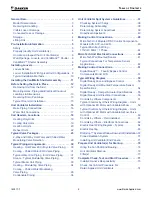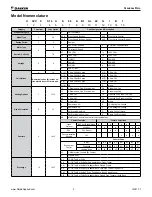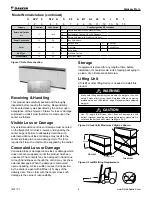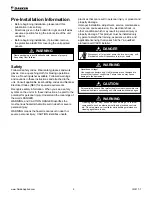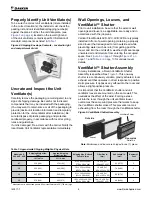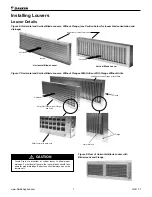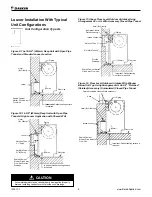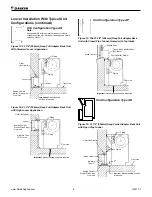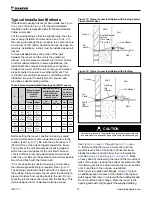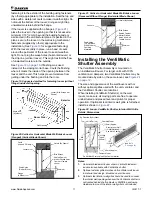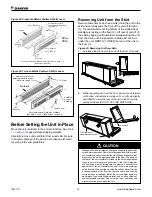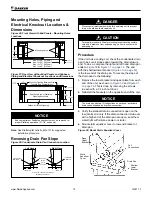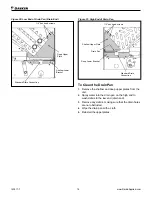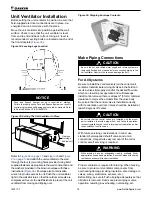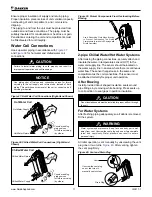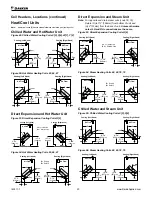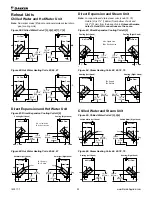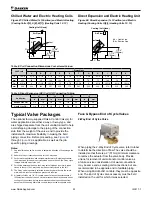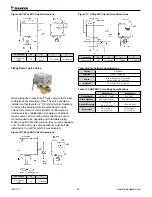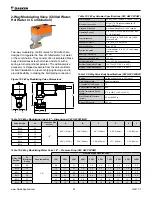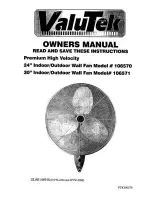
IM 817-7
10 www.DaikinApplied.com
Typical Installation Methods
If the fresh air opening has not yet been made, see
locations and the job-specific plans for the exact location.
Follow local codes.
Cut the wall opening so that it is slightly larger than the
louver being installed. For dimensions, see
. If
the opening is already there, measure to be sure there is
a minimum of 3/8ʺ (9mm) clearance around all sides. For
masonry installations, a lintel must be installed above all
louvers.
In thick wall applications, the portion of the wall
between the louver and the unit is the outside air
plenum. Line this plenum area with 3/8ʺ (9 mm) mortar
or other suitable material. In some applications, the
job specifications require a metal sleeve connection
between the louver and the unit. If using such a sleeve,
properly caulk it to ensure a weather-tight seal. This
is critical in preventing freeze-ups, cold drafts, and air
infiltration. Be sure the wall is smooth, square, and
provides a suitable mating surface.
Table 2: Recommended Wall Openings For Wall Louvers
B
C
Recommended
Wall Openings
For Wall
Louvers
Maximum Number of
VentiMatic Shutters
Which Can Be
Mounted On Stan-
dard Louver
VentiMatic
Shutter(s)
Air Capacity
Maximum
Length Height
24
ʺ
Shutter
36
ʺ
Shutter
cfm
L/s
24"
(610)
27"
(659)
24
5
⁄
8
"
(613)
10
7
⁄
8
"
(267)
1
0
500
236
36"
(914)
39"
(991)
36
5
⁄
8
"
(918)
10
7
⁄
8
"
(267)
0
1
750
354
48"
(1219)
51"
(1295)
48
5
⁄
8
"
(1222)
10
7
⁄
8
"
(267)
2
0
1000
472
60"
(1524)
63"
(1600)
60
5
⁄
8
"
(1527)
10
7
⁄
8
"
(267)
1
1
1250
590
72"
(1829)
75"
(1905)
72
5
⁄
8
"
(1832)
19
7
⁄
8
"
(495)
0
2
1500
708
Before setting the louver, construct a sloping, sealed
cement mortar base to drain unwanted moisture to the
outside, (see
). Be sure the mortar base is 1ʺ
(25mm) thick at the unit and tapers toward the louver.
The mortar at the unit also acts as a backing against
which the open cell gasket of the unit itself can seal.
This is critical in preventing water leaks and air leaks
under the unit. Be sure the sealed cement mortar base is
smooth and flush with the interior wall.
If it is not possible to construct a sloping mortar base,
then field-supplied flashing is required. See
The flashing should terminate flush with the exterior of
the building. Place a bead of caulk under the flashing to
prevent moisture from wicking back to the unit. Do not
caulk the joint between the louver and the flashing. This
joint is designed to let unwanted moisture escape.
Figure 17: Typical Louver Installation with Sloping Sealed
Cement Mortar Base
Unit Gasket
Sealed Cement
Mortar;
Pitch Away
From Unit
Floor
Wall
Unit
Louver
No
Caulk
1" (25mm)
Figure 18: Typical Louver Installation with Flashing
Louver
No
Caulk
Unit Gasket
Wall
Unit
1" (25mm)
Floor
Caulk
(By
Others)
Flashing
(By
Others)
CAUTION
Personal injury hazard. Wear protective gloves to avoid possible cuts
and abrasions from exposed edges. Avoid contact with sharp edges.
. Before setting the louver, be sure the drain lip
(vertical louver) are at the bottom, horizontal louver
blades face down and the bird screen is towards the
unit. See
and
. Place
a heavy bead of caulk along the top and the two vertical
sides of the louver, leaving the bottom uncaulked so that
if moisture gets into the area between the louver and the
unit, it can drain to the outside, unrestricted.
If the louver is supplied with flanges, (
an additional bead of caulk on the inside of the top and
side flanges that come in contact with the building facade.
Do not caulk the bottom flange. Place the louver in the
opening and push it tight against the supplied building,


